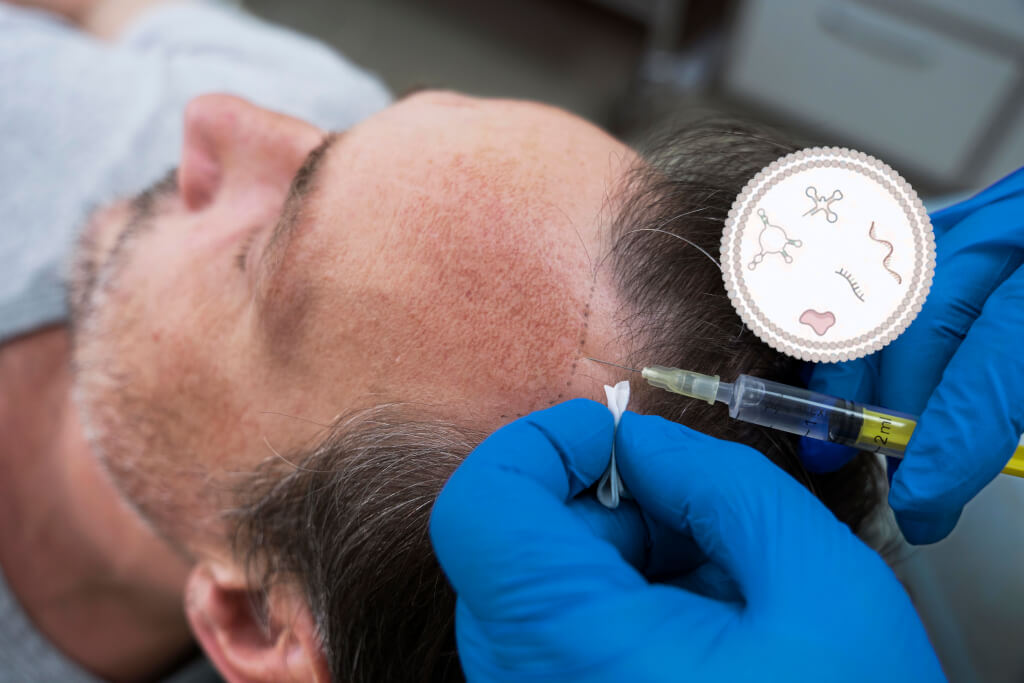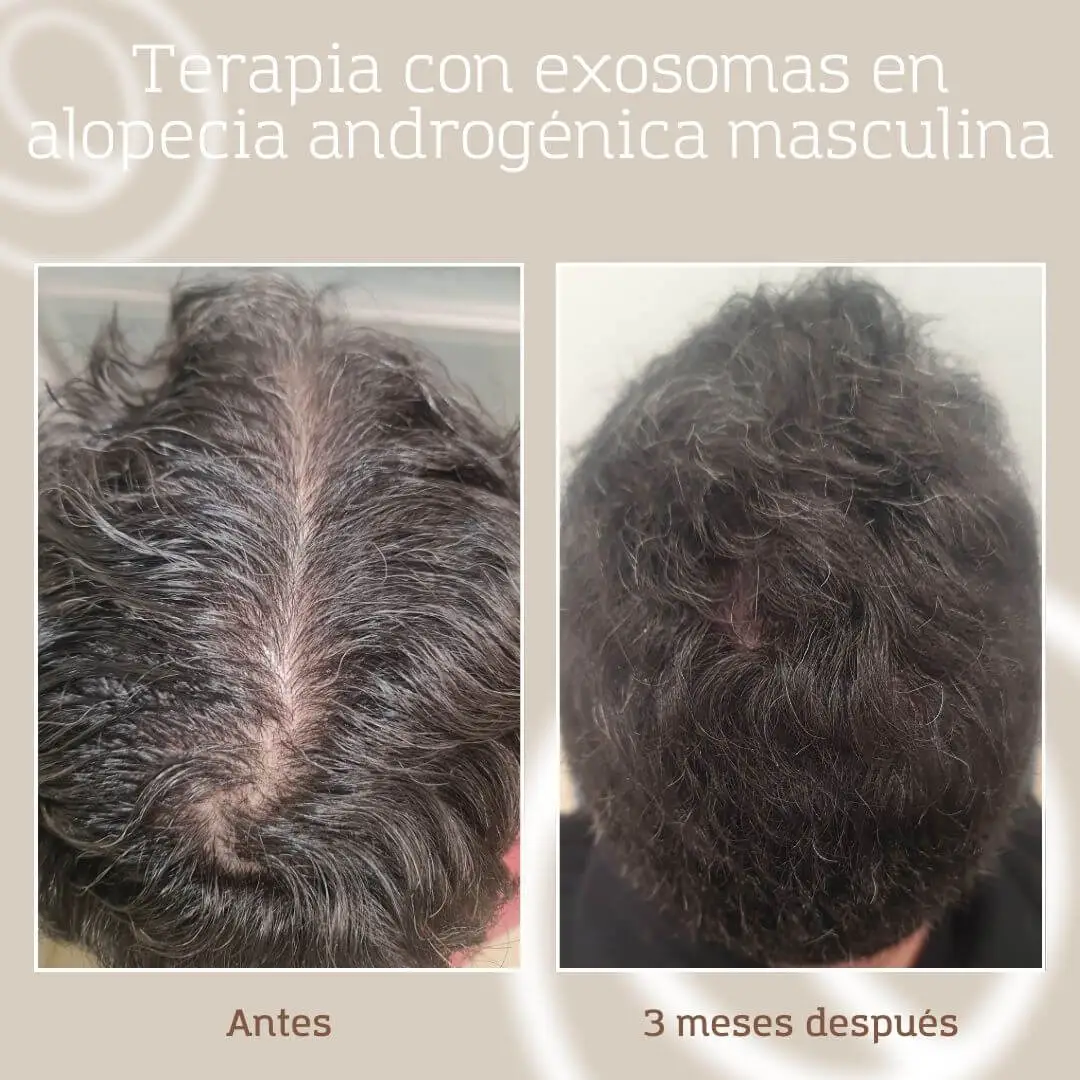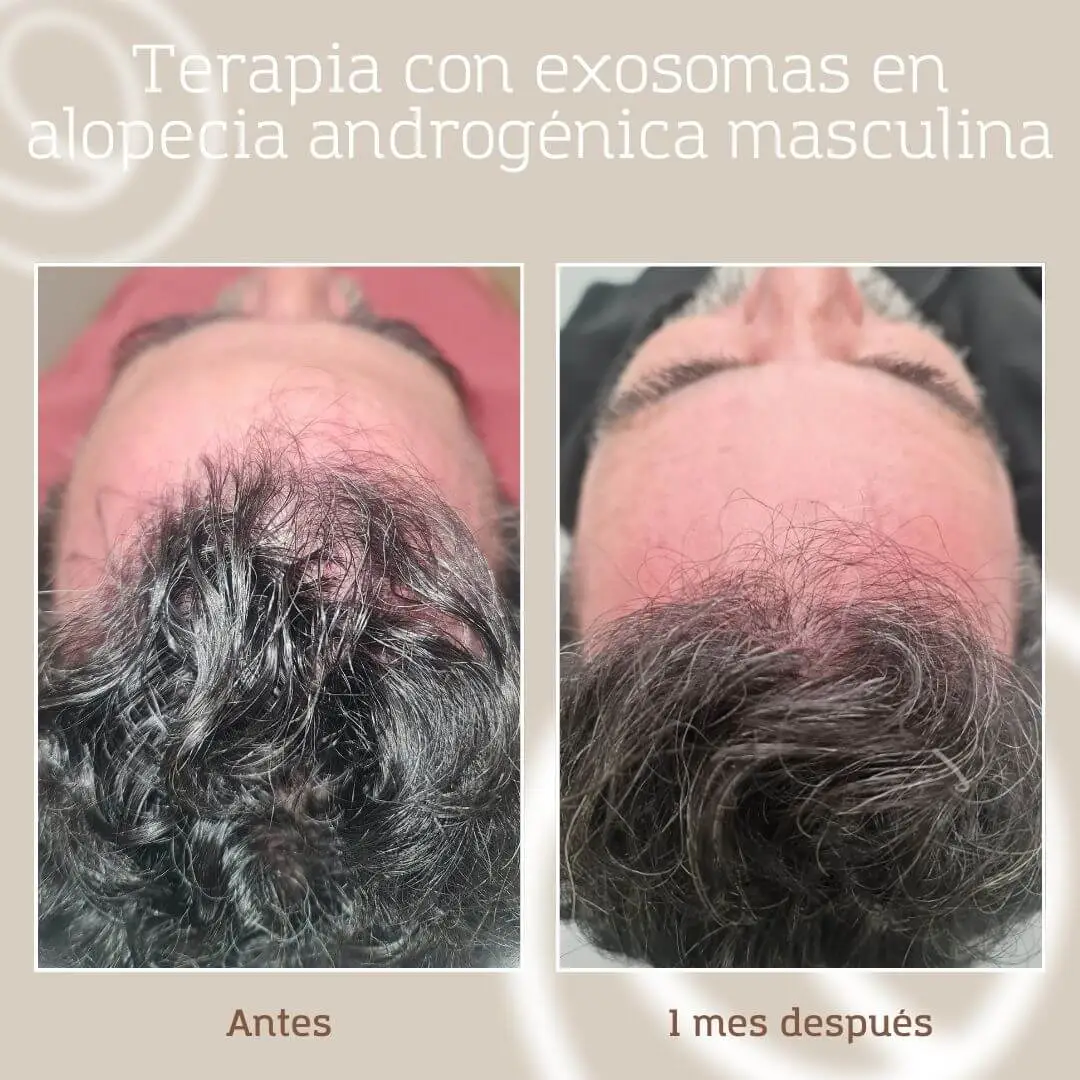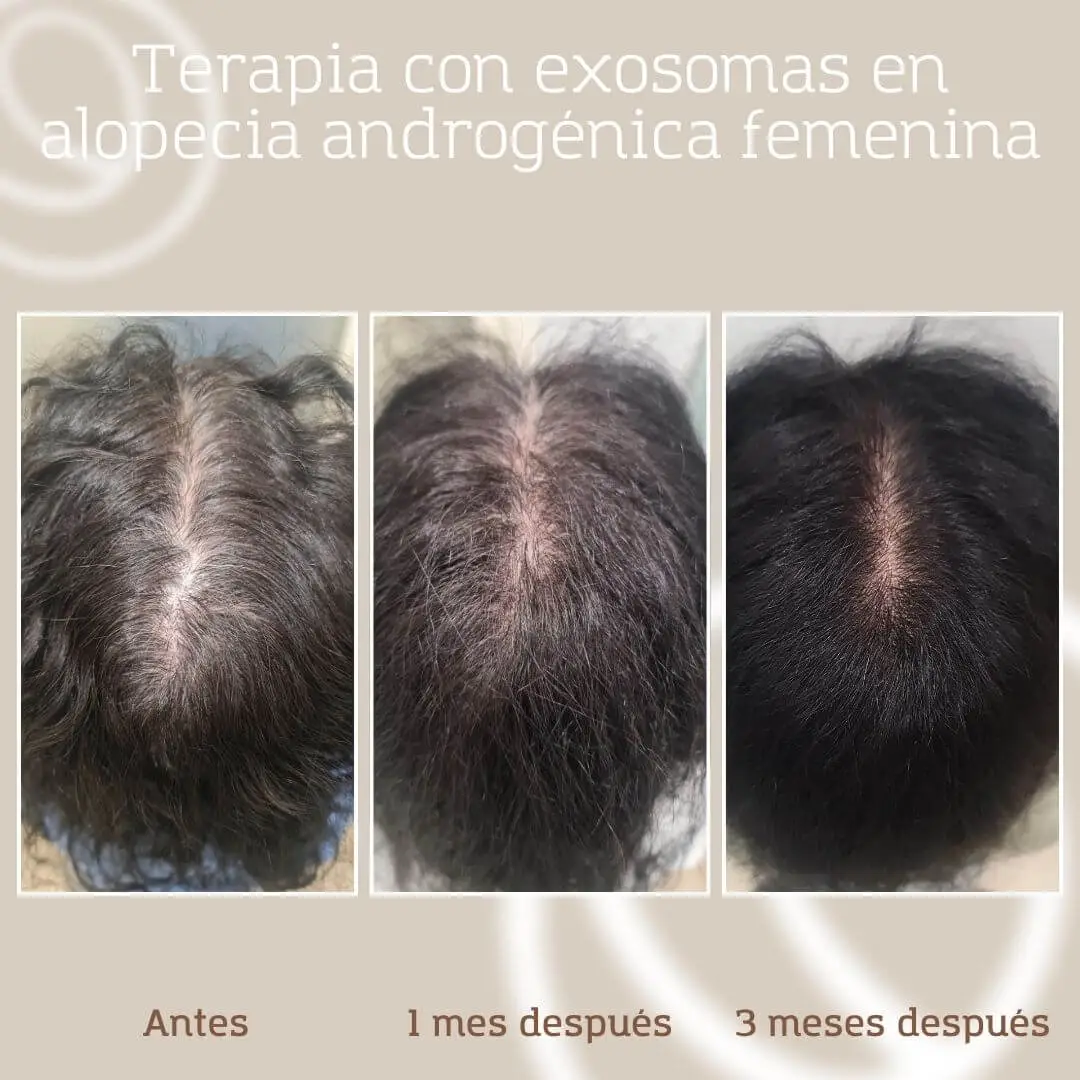
24 Aug
Exosome hair treatment: Does it work? What it does for your hair and the results
The medical battle against hair loss is still very much alive. In recent years there is a new therapy based on regenerative medicine that is increasingly being talked about: hair exosomes. If you’re considering it, I’ll tell you what they are, what the treatment is like, and whether they really give the good results many promise.
What are hair exosomes and what do they do to hair?
A cellular WhatsApp that regenerates hair
The Exosomes are like a cellular WhatsApp.
They are nanoscopic spherical “capsules” (nanovesicles) that cells release to communicate with other cells. As if they were messages that are sent to say “hey, do this or behave this way.” Split up, grow…
How do they work?
It turns out that inside they carry genetic material, proteins, lipids and other biomolecules. Components that are transferred from the donor cell (the one that sends the WhatsApp) to the recipient cell (the one that receives it), causing different responses.
Cell proliferation, blood vessel formation, inflammation suppression…
Answers for which your investigation is underway capillary regenerative potential (also in other fields of medicine). The idea is to “hack” this messaging system to “order” the cells to revitalize and make the hair grow.
For example, if we apply exosomes that stimulate the formation of microvessels in the scalp, more nutrients will arrive from the blood and could grow better.
I’m simplifying.
Specifically, it has been seen that these molecules could help to:
-
- Reverse damage to the follicle hairy, as the miniaturization and atrophy caused by androgens in androgenic alopecia.
- Restore hair’s natural growth capacity to increase thickness, shine, strength and resistance.
- Increase the number of hairs and stop its loss, enhancing growth and density.
Hence, they are attracting a lot of attention for:
-
- Treat common baldness, both in men and women.
- Reverse stress-related hair loss,hormonal changes, major surgery or sudden weight loss.
- Strengthen weakened hair due to age, medical treatment, air pollution or other environmental factors.
- Improve hair health and prevent possible hair loss in the future.
Not all exosomes act the same.
Exosomes have a peculiarity.
According to which cell proceeds, the effects may vary. In fact, this is a critical factor in the benefits that can be achieved with its application.
For example, studies suggest the following:
-
- Platelet exosomes. They promote hair follicle development, lengthen the anagen phase (during which hair grows), and stimulate circulation in the scalp (thus ensuring it is more oxygenated and nourished).
- From suppressor cells of myeloid origin. Possible immunomodulation and improvement of the follicular inflammatory state that occurs, for example, in alopecia areata or androgenic alopecia. They restore a favorable microenvironment for the hair follicle.
- From umbilical cord stem cells. They induce the proliferation of keratinocytes (they produce keratin, an essential component of hair).
- From dermal papilla cells. They restore hair growth by modulating the follicle’s environment. They improve follicular viability.
Hair regenerative effects have also been observed with exosomes from fibroblasts, bone marrow stem cells, adipose tissue (fat), etc.
It is an area under full investigation.
Furthermore, different approaches are being tested to optimize results:
-
- Exosomes loaded with active ingredients that support hair growth;
- Genetic engineering modifications to enhance the effects;
- Combination of therapies, etc.
A clarification, by the way.
Exosomes and stem cells are not the same thing. Both are used and researched as regenerative medicine treatments for hair loss, but they are different things. It’s like comparing bread and the baker.
What is exosome hair treatment?
How is it done and how many sessions are there?
Treatment with hair exosomes has its advantages.
First of all, we must explain where exosomes came from::
-
- Autologous exosomes. They come from the patient himself. They are the ones we apply in medical clinics as a regenerative medicine strategy.
- Heterologous. They are obtained through bioengineering or from other species. Plants, salmon roe, etc. They are used in cosmetics, as they are only used for topical use (even so there are those who inject them, be very careful…).
- Allogeneic. They come from another person, for example from the umbilical cord. They are only used in the field of research because of the cost involved.
I am talking about the first ones, which are the ones that concern us.
Its application is minimally invasive, very comfortable for the patient. We infiltrate them into the scalp by covering the areas to be regenerated, usually with mesotherapy microinjections or with a microneedling system.
Now, the following happens, and that is that the way to obtain them is critical. Why? Today it can only be done with autologous plasma for clinical indications, but there are different procedures and technologies that affect its purity, integrity and stability.
That conditions its effectiveness and therefore the results.
At Canons Clinics we use exosmart. It is a device that allows us to obtain autologous exosomes in very high concentration together with growth factors and other bioactive molecules.
The hair regenerative potential is very high.
The protocol we follow is this:
- Blood extraction of the patient and centrifuged.
- Exosome separation by ultrafiltration of the plasma obtained.
- Intradermal application (in the dermis) with microinjections. We focus more on areas with less hair.
- One 30-minute session per year. Enough to achieve therapeutic efficacy and observe benefits. Two at most, depending on need.
In the video you can see how the product is injected.
They are very fine needles.
Its application is minimally invasive, very comfortable for the patient. We infiltrate them into the scalp by covering the areas to be regenerated, usually with mesotherapy microinjections or with a microneedling system.
Now, the following happens, and that is that the way to obtain them is critical. Why? Today it can only be done with autologous plasma for clinical indications, but there are different procedures and technologies that affect its purity, integrity and stability.
That conditions its effectiveness and therefore the results.
At Canons Clinics we use exosmart. It is a device that allows us to obtain autologous exosomes in very high concentration together with growth factors and other bioactive molecules.
The hair regenerative potential is very high.
The protocol we follow is this:
- Blood extraction of the patient and centrifuged.
- Exosome separation by ultrafiltration of the plasma obtained.
- Intradermal application (in the dermis) with microinjections. We focus more on areas with less hair.
- One 30-minute session per year. Enough to achieve therapeutic efficacy and observe benefits. Two at most, depending on need.
In the video you can see how the product is injected.
They are very fine needles.
Results: visible effects, when they are seen and 1 case
The theory is fine…
But what results can you expect with autologous hair exosomes? I’m talking to you from our experience at Cànons Clinics.
You notice this therapy especially in the quantity and quality of your hair:
-
- Greater volume and density. The treated areas are more populated.
- Stronger, more youthful hair. Overall, it appears more alive and healthy.
To evaluate it we carry out periodic monitoring.
Around 50% of patients already see these benefits one month after treatment, which is when we conduct the first assessment. The second checkup is after three months, and 80% of patients already have clear results.
Many continue to improve from there.
After 6 months, we schedule another appointment to decide when to do the next sessions. These are usually 9-12 months after the initial session, depending on the progress we see.
I’ll show you a case.
A patient with androgenic alopecia who recently came to my office. After studying his needs, we applied exosomes.
Before and after:
What side effects do they have?
Hair exosomes are generally very well tolerated.
It is true that it is crucial to tailor treatment to each patient. Excessive doses could lead to infections and certain risks from unwanted cellular responses.
But most commonly they only produce one slight tingling or irritation on the scalp after administration.
Pros and cons of hair exosomes: is it the best?
Comparison with other regenerative therapies
Regenerative medicine is booming.
Today there are 3 treatments for hair loss within this group:
-
- Extracellular vesicles (capillary exosomes come in here).
- Platelet-concentrated plasma.
- Stem cells.
Regarding platelet-concentrated plasma, its effects are partly due to the exosomes they release. By separating, concentrating, and applying these directly, we are observing equal or better results with fewer sessions.
One a year compared to 2-4 for plasma.
Regarding stem cells these pose certain risks due to their capacity for self-renewal and differentiation. These include immune rejection, tumor development, etc.
If instead of using the whole soldier, who can get out of control (the mother cell), we use only a sword (exosomes like the ones it produces)… it’s safer.
Less risk of rejection, tumor formation, etc.
The biggest disadvantage of exosomes
Let’s put our feet on the ground.
The main drawback of hair exosomes is that it is a therapy still in its infancy. Scientific evidence is still scarce and inconclusive. There are no standardized protocols, and long-term efficacy and safety studies are lacking.
It’s true that they’re proving very promising against alopecia. Many doctors are testing their effectiveness in selected cases.
But let’s be realistic… There’s still research to be done.
What we recommend at Cànons Clinics
The key to exosomes is in the indication.
That is to say, they are neither the best nor the worst treatment for hair loss. Depending on the patient, they may be recommended and provide very good results, or they may be the opposite. They may not be worthwhile, and other options with even more scientific support may be preferable.
For example, exosomes will never replace hair transplant. However, If there’s only a slight loss of density or a slight receding of the hairline, they may be sufficient. They’re much less invasive and offer noticeable benefits.
And then something I always mention in the consultation.
These regenerative therapies make little sense without good habits. We seek to revitalize the scalp to stimulate hair growth. If you follow damaging it with a poor diet, smoking, etc., the effectiveness will be minimal.
Therefore, in Clinical Canons the first thing we do is assess the degree of alopecia, possible causes, hair characteristics, expectations, medical history…
Based on this we determine what is most appropriate.
We indicate exosomes especially in:
-
- Mild or moderate alopecia, combining with lifestyle and personal care measures such as lotions or supplements.
- Maintenance of more advanced alopecia in people who do not want to resort to surgery.
And to enhance results after a transplant? It could be, but there are no studies on the subject. We’re looking at other options.
What is true, men and women can benefit from this treatment.
Look at this patient:
Can you tell me your case?
We have several patients in Cànons Clinic whose hair exosomes have worked very well for them, but perhaps other alternatives are better for you.
Why not come to our clinic and check it?
We are in Barcelona and Granollers.
You can make an appointment by calling 683 27 07 09, writing to that number via WhatsApp or filling out the form you can access from the button below.
It will be a pleasure to assist you and answer your questions.
More information
If you’d like to investigate further…
-
- Poddar N, Aratikatla A, Gupta A. Therapeutic potential of stem cell-derived exosomes in hair regeneration: A systematic review. World J Stem Cells. 2025 Jul 26;17(7):108519. Source.
- Lu C et al. Platelet-rich plasma-derived exosomes stimulate hair follicle growth through activation of the Wnt/β-Catenin signaling pathway. Regen Ther. 2025 Apr 17;29:435-446. Source.
- Liu Y et al. Subcutaneous injection of genetically engineered exosomes for androgenic alopecia treatment. Front Bioeng Biotechnol. 2025 May 30;13:1614090. Source.
- Wu X, Tang S. Advances in the extracellular vesicles treatment of alopecia. Ann Med. 2025;57(1):2543517. Source.
- Spakova T, Janockova J, Rosocha J. Characterization and Therapeutic Use of Extracellular Vesicles Derived from Platelets. Int J Mol Sci. 2021 Sep 8;22(18):9701. Source.
- Exosmart. Autologous Exosomes Therapy [Internet]. 2022 [cited aug 12 2025]. Source.
Dr. Víctor Hernàndez Machado.
Medical Director of Cànons Clinics
Plastic surgeon specializing in facial surgery and body contouring, with experience in the private sector since 2001. I advocate for honest aesthetic surgery and medicine in which results improve, not change.
Registered doctor in Barcelona number 30493, member of the SECPRE and general secretary of the Spanish Society of Surgical Medical Lasers (SELMQ).
Currículum. LinkedIn.





Sorry, the comment form is closed at this time.